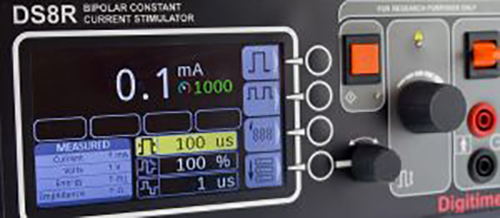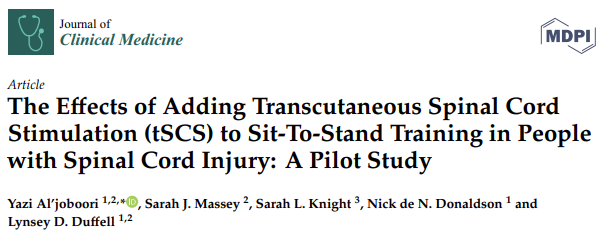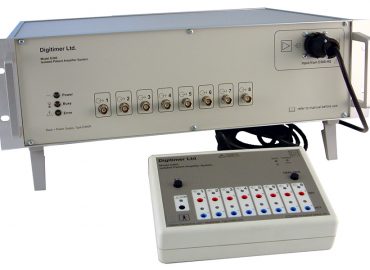Spinal Cord Injury and Transcutaneous Spinal Cord Stimulation
J. Clin. Med. Special Issue features multiple studies using DS7A and DS8R Stimulators
 In a special issue of the Journal of Clinical Medicine, edited by Dr. Ursula S. Hofstoetter and Dr. Karen Minassian of the Medical University of Vienna, research papers from several international centres are presented, highlighting ongoing research in the area of spinal cord injury. These papers discuss the results of investigations into a potential role for transcutaneous electrical spinal cord stimulation. Transcutaneous spinal cord stimulation is attracting a lot of attention due to its non-invasive nature and the fact that high-frequency stimulation also appears to be well tolerated by individuals with SCI.
In a special issue of the Journal of Clinical Medicine, edited by Dr. Ursula S. Hofstoetter and Dr. Karen Minassian of the Medical University of Vienna, research papers from several international centres are presented, highlighting ongoing research in the area of spinal cord injury. These papers discuss the results of investigations into a potential role for transcutaneous electrical spinal cord stimulation. Transcutaneous spinal cord stimulation is attracting a lot of attention due to its non-invasive nature and the fact that high-frequency stimulation also appears to be well tolerated by individuals with SCI.
Recent research has demonstrated improvements in motor function thought to be completely lost due to severe spinal cord injury and spinal cord stimulators, while other studies have examined a potential role for these methods in spasticity management as an alternative to medications that are often accompanied by undesired side effects.
“As a noninvasive intervention, transcutaneous spinal cord stimulation holds the great potential to find its way into wide clinical application. Its firm establishment and lasting acceptance as clinical practice in spinal cord injury will not only hinge on the demonstration of safety and efficacy, but also on the delineation of a conceptual framework of the underlying physiological mechanisms.”
This special issue features no less than five original research articles that cite the use of Digitimer DS7A and/or DS8R high voltage constant current stimulators. The medically certified DS7A has been employed for related neurophysiological research for over thirty years, but the recent introduction of the DS8R research stimulator has enhanced the ability of researchers to deliver stimulation protocols that might include frequencies up to 10kHz or to automate stimulus delivery via software control. The DS8R is already involved in several multi-centre clinical trials, aimed at examining the efficacy of transcutaneous spinal cord stimulation in people with spinal cord injuries.

The complete journal issue can be accessed here, but below are the papers that specifically use Digitimer stimulators in their research.
Steele, A.G.; Atkinson, D.A.; Varghese, B.; Oh, J.; Markley, R.L.; Sayenko, D.G. Characterization of Spinal Sensorimotor Network Using Transcutaneous Spinal Stimulation during Voluntary Movement Preparation and Performance. J. Clin. Med. 2021, 10, 5958. https://doi.org/10.3390/jcm10245958
Abstract
Transcutaneous electrical spinal stimulation (TSS) can be used to selectively activate motor pools based on their anatomical arrangements in the lumbosacral enlargement. These spatial patterns of spinal motor activation may have important clinical implications, especially when there is a need to target specific muscle groups. However, our understanding of the net effects and interplay between the motor pools projecting to agonist and antagonist muscles during the preparation and performance of voluntary movements is still limited. The present study was designed to systematically investigate and differentiate the multi-segmental convergence of supraspinal inputs on the lumbosacral neural network before and during the execution of voluntary leg movements in neurologically intact participants. During the experiments, participants (N = 13) performed isometric (1) knee flexion and (2) extension, as well as (3) plantarflexion and (4) dorsiflexion. TSS consisting of a pair pulse with 50 ms interstimulus interval was delivered over the T12-L1 vertebrae during the muscle contractions, as well as within 50 to 250 ms following the auditory or tactile stimuli, to characterize the temporal profiles of net spinal motor output during movement preparation. Facilitation of evoked motor potentials in the ipsilateral agonists and contralateral antagonists emerged as early as 50 ms following the cue and increased prior to movement onset. These results suggest that the descending drive modulates the activity of the inter-neuronal circuitry within spinal sensorimotor networks in specific, functionally relevant spatiotemporal patterns, which has a direct implication for the characterization of the state of those networks in individuals with neurological conditions.
Wecht, J.R.; Savage, W.M.; Famodimu, G.O.; Mendez, G.A.; Levine, J.M.; Maher, M.T.; Weir, J.P.; Wecht, J.M.; Carmel, J.B.; Wu, Y.-K.; Harel, N.Y. Posteroanterior Cervical Transcutaneous Spinal Cord Stimulation: Interactions with Cortical and Peripheral Nerve Stimulation. J. Clin. Med. 2021, 10, 5304. https://doi.org/10.3390/jcm10225304
Abstract
Transcutaneous spinal cord stimulation (TSCS) has demonstrated potential to beneficially modulate spinal cord motor and autonomic circuitry. We are interested in pairing cervical TSCS with other forms of nervous system stimulation to enhance synaptic plasticity in circuits serving hand function. We use a novel configuration for cervical TSCS in which the anode is placed anteriorly over ~C4–C5 and the cathode posteriorly over ~T2–T4. We measured the effects of single pulses of TSCS paired with single pulses of motor cortex or median nerve stimulation timed to arrive at the cervical spinal cord at varying intervals. In 13 participants with and 15 participants without chronic cervical spinal cord injury, we observed that subthreshold TSCS facilitates hand muscle responses to motor cortex stimulation, with a tendency toward greater facilitation when TSCS is timed to arrive at cervical synapses simultaneously or up to 10 milliseconds after cortical stimulus arrival. Single pulses of subthreshold TSCS had no effect on the amplitudes of median H-reflex responses or F-wave responses. These findings support a model in which TSCS paired with appropriately timed cortical stimulation has the potential to facilitate convergent transmission between descending motor circuits, segmental afferents, and spinal motor neurons serving the hand. Studies with larger numbers of participants and repetitively paired cortical and spinal stimulation are needed.
Calvert, J.S.; Gill, M.L.; Linde, M.B.; Veith, D.D.; Thoreson, A.R.; Lopez, C.; Lee, K.H.; Gerasimenko, Y.P.; Edgerton, V.R.; Lavrov, I.A.; Zhao, K.D.; Grahn, P.J.; Sayenko, D.G. Voluntary Modulation of Evoked Responses Generated by Epidural and Transcutaneous Spinal Stimulation in Humans with Spinal Cord Injury. J. Clin. Med. 2021, 10, 4898. https://doi.org/10.3390/jcm10214898
Abstract
Transcutaneous (TSS) and epidural spinal stimulation (ESS) are electrophysiological techniques that have been used to investigate the interactions between exogenous electrical stimuli and spinal sensorimotor networks that integrate descending motor signals with afferent inputs from the periphery during motor tasks such as standing and stepping. Recently, pilot-phase clinical trials using ESS and TSS have demonstrated restoration of motor functions that were previously lost due to spinal cord injury (SCI). However, the spinal network interactions that occur in response to TSS or ESS pulses with spared descending connections across the site of SCI have yet to be characterized. Therefore, we examined the effects of delivering TSS or ESS pulses to the lumbosacral spinal cord in nine individuals with chronic SCI. During low-frequency stimulation, participants were instructed to relax or attempt maximum voluntary contraction to perform full leg flexion while supine. We observed similar lower-extremity neuromusculature activation during TSS and ESS when performed in the same participants while instructed to relax. Interestingly, when participants were instructed to attempt lower-extremity muscle contractions, both TSS- and ESS-evoked motor responses were significantly inhibited across all muscles. Participants with clinically complete SCI tested with ESS and participants with clinically incomplete SCI tested with TSS demonstrated greater ability to modulate evoked responses than participants with motor complete SCI tested with TSS, although this was not statistically significant due to a low number of subjects in each subgroup. These results suggest that descending commands combined with spinal stimulation may increase activity of inhibitory interneuronal circuitry within spinal sensorimotor networks in individuals with SCI, which may be relevant in the context of regaining functional motor outcomes.
Sasaki, A.; de Freitas, R.M.; Sayenko, D.G.; Masugi, Y.; Nomura, T.; Nakazawa, K.; Milosevic, M. Low-Intensity and Short-Duration Continuous Cervical Transcutaneous Spinal Cord Stimulation Intervention Does Not Prime the Corticospinal and Spinal Reflex Pathways in Able-Bodied Subjects. J. Clin. Med. 2021, 10, 3633. https://doi.org/10.3390/jcm10163633
Abstract
Cervical transcutaneous spinal cord stimulation (tSCS) has been utilized in applications for improving upper-limb sensory and motor function in patients with spinal cord injury. Although therapeutic effects of continuous cervical tSCS interventions have been reported, neurophysiological mechanisms remain largely unexplored. Specifically, it is not clear whether sub-threshold intensity and 10-min duration continuous cervical tSCS intervention can affect the central nervous system excitability. Therefore, the purpose of this study was to investigate effects of sub-motor-threshold 10-min continuous cervical tSCS applied at rest on the corticospinal and spinal reflex circuit in ten able-bodied individuals. Neurophysiological assessments were conducted to investigate (1) corticospinal excitability via transcranial magnetic stimulation applied on the primary motor cortex to evoke motor-evoked potentials (MEPs) and (2) spinal reflex excitability via single-pulse tSCS applied at the cervical level to evoke posterior root muscle (PRM) reflexes. Measurements were recorded from multiple upper-limb muscles before, during, and after the intervention. Our results showed that low-intensity and short-duration continuous cervical tSCS intervention applied at rest did not significantly affect corticospinal and spinal reflex excitability. The stimulation duration and/or intensity, as well as other stimulating parameters selection, may therefore be critical for inducing neuromodulatory effects during cervical tSCS.
Al’joboori, Y.; Massey, S.J.; Knight, S.L.; Donaldson, N.d.N.; Duffell, L.D. The Effects of Adding Transcutaneous Spinal Cord Stimulation (tSCS) to Sit-To-Stand Training in People with Spinal Cord Injury: A Pilot Study. J. Clin. Med. 2020, 9, 2765. https://doi.org/10.3390/jcm9092765
Abstract
Spinal cord stimulation may enable recovery of volitional motor control in people with chronic Spinal Cord Injury (SCI). In this study we explored the effects of adding SCS, applied transcutaneously (tSCS) at vertebral levels T10/11, to a sit-to-stand training intervention in people with motor complete and incomplete SCI. Nine people with chronic SCI (six motor complete; three motor incomplete) participated in an 8-week intervention, incorporating three training sessions per week. Participants received either tSCS combined with sit-to-stand training (STIM) or sit-to-stand training alone (NON-STIM). Outcome measures were carried out before and after the intervention. Seven participants completed the intervention (STIM N = 5; NON-STIM N = 2). Post training, improvements in International Standards for Neurological Classification of Spinal Cord Injury (ISNCSCI) motor scores were noted in three STIM participants (range 1.0–7.0), with no change in NON-STIM participants. Recovery of volitional lower limb muscle activity and/or movement (with tSCS off) was noted in three STIM participants. Unassisted standing was not achieved in any participant, although standing with minimal assistance was achieved in one STIM participant. This pilot study has shown that the recruitment of participants, intervention and outcome measures were all feasible in this study design. However, some modifications are recommended for a larger trial.
Find out more about our product range
If you want to find out more about the DS7A or DS8R Stimulators or any other Digitimer products that can be used in this type of research, please get in touch with us.



